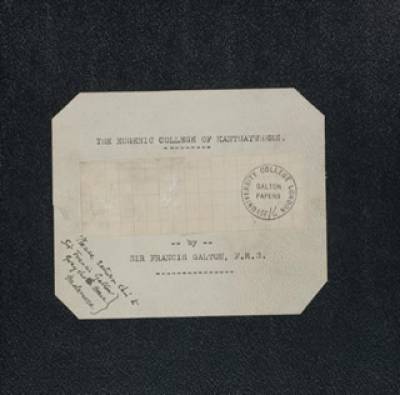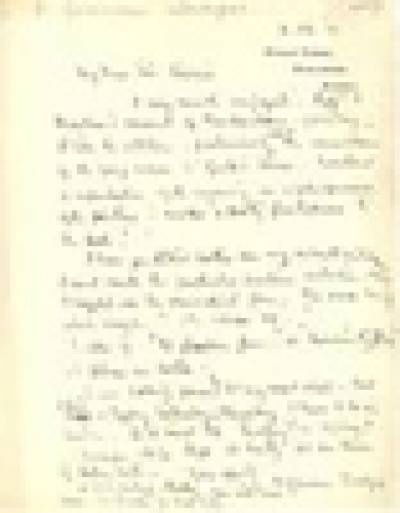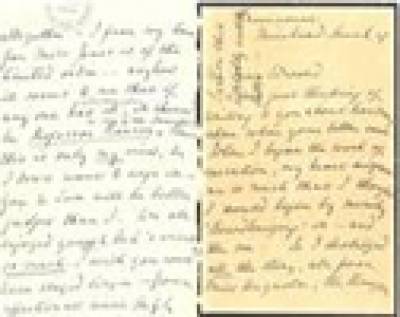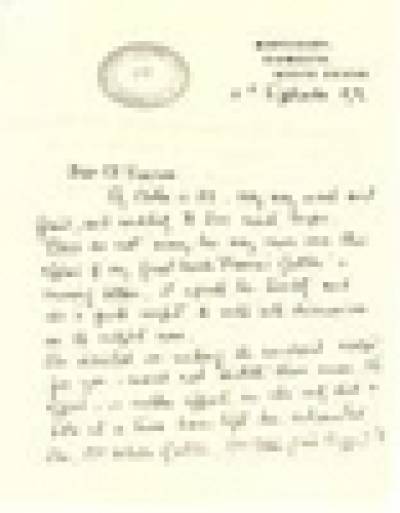UCL Special Collections holds the manuscript fragment of Sir Francis Galton's unpublished utopian novel.
This manuscript for The Eugenic College of Kantsaywhere (c.1910) is part of the Galton Archive.
In 2011, marking the centenary of Galton's death, UCL Library Services made a digital copy of the work available online.

The novel is presented as 'Extracts from the Journal of the late Professor I. Donoghue'. Donoghue, from Dunno Weir, is a professor of vital statistics who arrives in Kantsaywhere and submits to a series of examinations for a eugenics degree in order to be eligible to marry the object of his affections, Miss Allfancy.
After Galton's death, the single remaining copy published here was bowdlerised by his niece Milly who "destroyed all the story, all poor Miss Augusta, the Nonnyson anecdotes, and in fact everything not to the point". What remained was passed to Galton's biographer, Professor Karl Pearson.
Below, writer and broadcaster Dr Matthew Sweet introduces the novel and sets it in its contemporary contexts. There are also opportunities to view the full text of the work and letters about its suitability for publication. In addition, an overview of the UCL Library Services Galton exhibition is offered including a link to the electronic representation of the showcase.
- Introduction by Dr Matthew Sweet
Francis Galton invented the weather map and revolutionised forensic science - but the reason why he is historically important is probably the reason why he is so little known today. Galton is the man who coined the word "eugenics" - a body of thought that we now regard as irremediably toxic; reject as a pseudoscience that was once used to naturalise racism and justify the view that some humans are less human than others. It remains one of the dirtiest words in the lexicon of western thought.
In late Victorian and Edwardian Britain, Galton embodied the theories and the aspirations of the eugenics movement: the dream of a society populated by healthy, well-educated individuals, untroubled by hereditary disease - or by the presence of those who did not fit that pattern. The tenets of this movement were derived from evolutionary theory - from the work of Charles Darwin, and more particularly from that of Herbert Spencer, who applied Darwinian thinking to human populations and added the term "survival of the fittest" to the English language1. It was also founded upon one of the great enthusiasms of the nineteenth century - an interest in the power of data, statistics and tables. Just as the social reformer Charles Booth mapped the relative wealth and poverty of the citizens of London, and Dr John Snow collated and tabulated the information that led to his discovery of the waterborne nature of cholera, eugenicists examined the topography of the face, calculated body weight, judged height and tested mathematical and linguistic ability. With this information, they attempted to assess the mental and physical fitness of populations, and ask how their most desirable traits might be managed and improved, and their worst ones eliminated. But even in a world that had not heard of Auschwitz, there were some who expressed doubts about the value of this research.
The Eugenics Education Society was formed in 1907. Galton died in January 1911, when its ideas were gaining ground. At the time of his death he was working on a book that aimed to offer a vision of a society shaped and governed by the principles of eugenics. The book was never published in its entirety. His family found it so troubling that they suppressed it and destroyed parts of the typescript. Their objections seem to have been twofold: an anxiety about the sexual propriety of some of its scenes, and an astonishingly prescient discomfort with the political implications of eugenic thinking. What remains of the book is collected on this website.
The Eugenic College of Kantsaywhere is a science fiction novel set in a country dedicated to the improvement of the human species by manipulating the sex lives of its inhabitants. "In Kantsaywhere," we're told, "they think more of the race than of the individual." Here, prospective parents are required to undergo physical and psychometric tests before being pronounced fit to reproduce - and those found unfit are banished from the state. People denied the privilege of parenthood become the responsibility of a government agency that ships them to labour colonies where "sharp severity" is promised if they are sufficiently unwise to break a pledge of celibacy.
It is a plot that feels familiar, thanks to its echoes in twentieth-century science fiction: Aldous Huxley's Brave New World (1932) in which babies are spawned in bottles and conditioned to suit the purposes of a consumerist state; John Wyndham's The Chrysalids (1955), where the character of Sophie knows her sixth toe is evidence that she is one of the genetic mutations so feared and despised by her community; Andrew Niccol's film Gattaca (1997)in which those judged genetically imperfect connive to pass DNA tests by submitting the samples of their chromosomal betters, purchased on a black market in bodily fluids. These, of course, are examples of dystopian fiction. What is striking about Kantsaywhere is that it is a place in which Francis Galton clearly wanted to live. A later version of a similar story might have depicted the outcasts in the labour colonies reclaiming their right to sex and reproduction. Such an idea, however, would have been anathema to Galton. Kantsaywhere offers a design for living in a eugenic state, one sufficiently detailed that it might have been used as a starting point for anyone daring enough to try.
The novel opens with the details of a bequest. A Mr Cory has died, and died rich. His posthumous wealth, he has stipulated, must be used to effect a philanthropic plan - to improve the "stock" of Kantsaywhere (in both the horsey and the capitalist sense) by encouraging members with the greatest number of "heritable gifts" to reproduce as enthusiastically as possible. This money, his will warns, must not be spent upon "the support of the naturally feeble." Quite the reverse. The Cory fortune is to be disbursed "to help those who were strong by nature to multiply and to be well nourished." And it is the process by which its inhabitants are assessed that is the most intense object of Galton's interest.
The examinations of candidates for the Eugenic College of Kantsaywhere are described in meticulous and faintly eroticised terms. Galton describes the hall in which they take place, the tables upon which the bodies of candidates are measured and mapped. Then comes a physical assessment in an outdoor enclosure, a ritual somewhere between an Army medical and the Badminton Horse Trials, which includes a test of strength of grip, lung capacity, colour sense, acuity of hearing, sensitivity of taste and touch, and dental health. A third session puts the literary and aesthetic skills of candidates to work: they read aloud from poetry and prose extracts, they sing, they compose a short essay. A fourth comprises a thorough medical examination. The fifth and final process is an assessment of the pedigree of a candidate, at which ancestral gifts are weighed against inherited deficiencies. Those with sketchy information about their forbears are unlikely to progress. "All immigrants," we're told, "are more or less suspected."
The late nineteenth century saw a flowering of fiction that located its action in a wildly transformed version of human society. Edwin Abbott's Flatland: A Romance of many Dimensions (1884), used geometry to satirise the class system of his era: under the law of this state, irregular polygons are dismembered for their wayward angles, or demoted to an inferior social caste. In News from Nowhere (1890), William Morris projected his narrator into a future London populated by socialist artisans. In The Time Machine (1895), HG Wells imagined a world in which the social divisions of industrial society had become fixed in human biology - in the bowels of the earth, the bestial Morlocks toiled with strange machines, while on the sunlit surface, the child-like Eloi frolicked in mimsy indolence. Edward Bulwer-Lytton's The Coming Race (1871) introduced the Vril-ya, a race of superhuman beings living in cities built within a vast subterranean cave system, where they listen to organ recitals and leave the household chores to anthropomorphic robots, powered - like everything else in their realm - by a strange biological energy called Vril. These alternative worlds form the context of Kantsaywhere: in Galton's lifetime, fiction had become a laboratory for speculative social experiments, a place for thinking the unthinkable.
Several of these novels exerted a palpable influence upon the world. In A Modern Utopia (1905) HG Wells theorised an emergent elite class of "Samurai" who might assert an executive power over the earth's population - and, as the twentieth century progressed, many of his contemporaries found a strong appeal in the idea of a more authoritarian, less democratic state. Some readers of The Coming Race were so excited by the concept of a society of super-evolved humanoid beings that they entertained fantasies of joining it. There were cultish groups who believed that Vril-power was a real force, and might be generated and directed through elaborate breathing exercises2. Although none of them succeeded in projecting beams of energy from their wrists, the impact made by such ideas is memorialised on the shelves of every British supermarket that stocks the concentrated beef drink, Bovril.
Kantsaywhere was never published in any popular form, but it shares common ground with the intellectual, political and medical culture of its time. The raw data for Galton's own research came from families whom he paid to carry out tests upon themselves - they posted off their vital statistics and their family trees, and received an envelope containing a five pound note. Such experiments were regarded as entirely unsensational, and formed part of broader project to measure the fitness of the nation.
In 1899 the Boer War exposed the poor physical development of urban working-class men - a worryingly high percentage of recruits found themselves rejected for service on medical grounds. An interdepartmental Committee on Physical Deterioration was established in 1903, and the following year, recommended regular medical inspections of schoolchildren, free meals for the poorest pupils, and parenting classes for their mothers. When the Liberal Party won its landslide election victory in 1906, it came to power with a mandate to pursue further reforms: state health insurance, unemployment benefit, old age pensions. In 1942 the Beveridge Report recommended the enormous extension of these schemes into a fully comprehensive welfare system. It may come as a surprise to users of the National Health Service that its political midwife, William Beveridge, was an enthusiastic eugenicist, who, in Galton's lifetime, spoke like a character from Kantsaywhere. In 1906 he asserted that "those men who through general defects are unable to fill such a whole place in industry, are to be recognised as 'unemployable'. They must become the acknowledged dependents of the State … but with complete and permanent loss of all citizen rights - including not only the franchise but civil freedom and fatherhood." 3
So the land of Kantsaywhere is, despite the coyness of the title, a country that may not be quite so alien as it first appears. Some version of its structures and processes are legible in the OFSTED report, in the psychometric test at the job interview, and on the internet dating site. You might also hear their echo in government statements on the wisdom of early intervention in the lives of children who have been judged statistically likely to develop into underachieving or socially disruptive adults.
An independent report published by the UK government in January 2011 - the centenary of Galton's death - opened its argument by presenting a pair of brain-scan images from two three year-old children. One was labelled "Normal", the other "Extreme Neglect". The brain of the neglected child appeared visibly underdeveloped. On the inside pages, the author of the report declared, "Early Intervention is the answer: a range of well-tested programmes, low in cost, high in results, can have a lasting impact on all children, especially the most vulnerable. If we intervene early enough, we can give children a vital social and emotional foundation which will help to keep them happy, healthy and achieving throughout their lives and, above all, equip them to raise children of their own, who will also enjoy higher levels of well-being." 4 This is a textbook eugenic idea - though few in government would dare to describe it as such.
Whether we welcome such ideas as a form of good works, or reject them as a form of soft authoritarianism, their instances in the past may help us decide their fate in the future. Kantsaywhere might form part of that debate. Certainly, averting our gaze from Francis Galton's extraordinary body of work will not assist us in reaching the right conclusions.
1In Herbert Spencer, Principles of Biology (1865).
2See Arthur Lovell, Ars Vivendi (1895), in which the author promises the reader "mastery of the nose."
3William Beveridge, The Problem of the Unemployed (1906), p. 327.
4Graham Allen, Early Intervention: The Next Steps (2011), p. ix. Online at https://www.gov.uk/government/publications/early-intervention-the-next-steps--2- Text

The Eugenic College of Kantsaywhere has been digitised in its entirety and is available to view with links to chapter headings and searchable content.
- Letters
After many modifications Galton offered the novel to the publisher Methuen. However, both publisher and members of Galton's family considered it unsuitable for publication. Galton himself concluded that 'Kantsaywhere must be smothered or be superseded. It has been an amusement and has cleared my thoughts to write it. So now let it go to "Wont-say-where".
Items of correspondence in the Galton archives refer to the controversy surrounding Kantsaywhere.

In a letter of 1910, the classicist Henry Graham Dakyns writes to Sir Francis, complimenting the author on Kantsaywhere.

In 1911, Milly Lethbridge, niece of Francis Galton, writes to Edward Galton Wheeler-Galton. Milly Lethbridge was given the task of destroying Francis Galton's manuscript novel Kantsaywhere. In this letter she refers to her unsuccessful attempts to redact passages from the text and asks Edward Galton to pass on the remainder to Karl Pearson.

Finally, in 1927, Lucy Amy Lethbridge, great-niece of Francis Galton, writes to Karl Pearson. Lethbridge advises Pearson that her mother, Mrs Wheeler Galton, Mrs Ellis and the publishers Methuen all agreed that the manuscript should be destroyed, and that this was also Galton's wish.
- Exhibition: An Enquiring Mind - Francis Galton 1822-1911
An exhibition of material from UCL Library Services Special Collections, with additional items on loan from UCL Museums & Collections, March-December 2011. Opened by Sir Mark Walport on 7 April 2011.
This exhibition in the Main Library was part of a Galton Centenary programme taking place at UCL to mark the anniversary of Sir Francis Galton's death in January 1911. Deposited at UCL by his executors, Special Collections holds papers and correspondence relating to Galton's personal history, family and scientific work, while Museums & Collections holds his scientific instruments and other personal memorabilia.
 Close
Close

